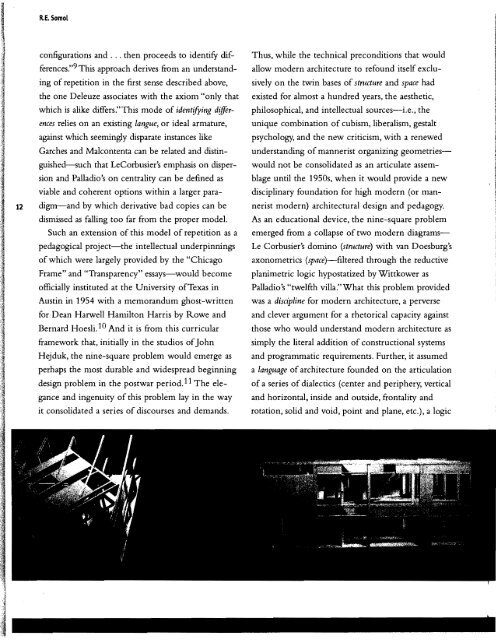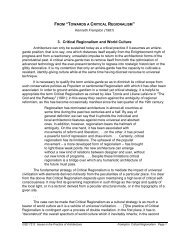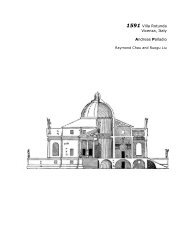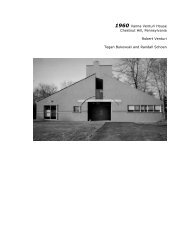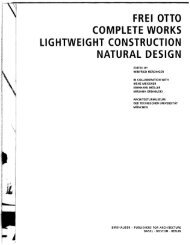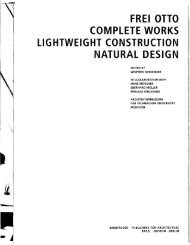Dummy Text, or The Diagrammatic - Introduction
Dummy Text, or The Diagrammatic - Introduction
Dummy Text, or The Diagrammatic - Introduction
You also want an ePaper? Increase the reach of your titles
YUMPU automatically turns print PDFs into web optimized ePapers that Google loves.
12<br />
R.E.Somol<br />
configurations and ... then proceeds to identify dif<br />
ferences."9 This approach derives from an understand<br />
ing of repetition in the first sense described above,<br />
the one Deleuze associates with the axiom "only that<br />
wbich is alike differs."This mode of identifying differ<br />
ences relies on an existing langue, <strong>or</strong> ideal armature,<br />
against which seemingly disparate instances like<br />
Garches and Malcontenta can be related and distin<br />
guished---such that LeC<strong>or</strong>busier's emphasis on disper<br />
sion and Palladio's on centrality can be defined as<br />
viable and coherent options within a larger para<br />
digm-and by which derivative bad copies can be<br />
dismissed as falling too far from the proper model.<br />
Such an extension of this model of repetition as a<br />
pedagogical project-the intellectual underpinnings<br />
of which were largely provided by the "Chicago<br />
Frame" and "Transparency" essays-would become<br />
officially instituted at the University ofTexas in<br />
Austin in 1954 with a mem<strong>or</strong>andum ghost-written<br />
f<strong>or</strong> Dean Harwell Hamilton Harris by Rowe and<br />
Bernard Hoesli.lO And it is from this curricular<br />
framew<strong>or</strong>k that, initially in the studios ofJohn<br />
Hejduk, the nine-square problem would emerge as<br />
perhaps the most durable and widespread beginning<br />
design problem in the postwar period. 11 <strong>The</strong> ele<br />
gance and ingenuity of this problem lay in the way<br />
it consolidated a series of discourses and demands.<br />
Thus, while the technical preconditions that would<br />
allow modern architecture to refound itself exclu<br />
sively on the twin bases of structure and space had<br />
existed f<strong>or</strong> almost a hundred years, the aesthetic,<br />
philosophical, and intellectual sources-Le., the<br />
unique combination of cubism, liberalism, gestalt<br />
psychology, and the new criticism, with a renewed<br />
understanding of mannerist <strong>or</strong>ganizing geometries<br />
would not be consolidated as an articulate assem<br />
blage until the 1950s. when it would provide a new<br />
disciplinary foundation f<strong>or</strong> high modern (<strong>or</strong> man<br />
nerist modern) architectural design and pedagogy.<br />
As an educational device, the nine-square problem<br />
emerged from a collapse of two modern diagrams<br />
Le C<strong>or</strong>busier's domino (structure) with van Doesburg's<br />
axonometrics (space)-filtered through the reductive<br />
planimetric logic hypostatized by Wittkower as<br />
Palladio's "twelfth villa."What this problem lJrovided<br />
was a discipline f<strong>or</strong> modern architecture, a perverse<br />
and clever argument f<strong>or</strong> a rhet<strong>or</strong>ical capacity against<br />
those who would understand modern architecture as<br />
simply the literal addition of constructional systems<br />
and programmatic requirements. Further, it assumed<br />
a language of architecture founded on the articulation<br />
of a series of dialectics (center and periphery, vertical<br />
and h<strong>or</strong>izontal, inside and outside, frontality and<br />
rotation, solid and void, point and plane, etc.), a logic


